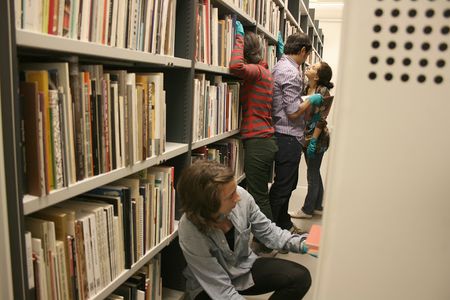Read-in: Difference between revisions
(added workshop -k) |
(added image) |
||
| Line 1: | Line 1: | ||
[[File:Read-in.jpg|450px|]] | |||
Read-in is a self-organized collective that experiments with the political, material, and physical implications of collective reading and the situatedness of any kind of reading activity. Some of the formats that Read-in experiments include are: going door-to-door and requesting neighbours to host a group reading session (Read-in Classic); workshops which focus on the links between reading and memorizing and experiments with memorizing collectively; and BookshelfResearch, for which Read-in examines specific private or public libraries according to categories such as gender, nationality, materiality, resulting in a statistical breakdown of inclusions and omissions. | Read-in is a self-organized collective that experiments with the political, material, and physical implications of collective reading and the situatedness of any kind of reading activity. Some of the formats that Read-in experiments include are: going door-to-door and requesting neighbours to host a group reading session (Read-in Classic); workshops which focus on the links between reading and memorizing and experiments with memorizing collectively; and BookshelfResearch, for which Read-in examines specific private or public libraries according to categories such as gender, nationality, materiality, resulting in a statistical breakdown of inclusions and omissions. | ||
Revision as of 16:11, 20 June 2017
Read-in is a self-organized collective that experiments with the political, material, and physical implications of collective reading and the situatedness of any kind of reading activity. Some of the formats that Read-in experiments include are: going door-to-door and requesting neighbours to host a group reading session (Read-in Classic); workshops which focus on the links between reading and memorizing and experiments with memorizing collectively; and BookshelfResearch, for which Read-in examines specific private or public libraries according to categories such as gender, nationality, materiality, resulting in a statistical breakdown of inclusions and omissions.
